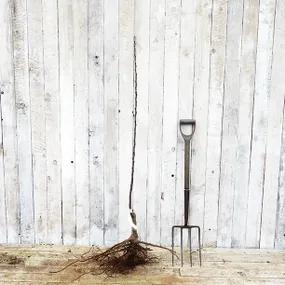Charles Ross Apple Trees
Honest Delivery Prices- Eating: Medium sweet, firm & juicy. Also used for cooking and sharp cider juice.
- Spur bearer (Good for cordons & espaliers)
- Partially self fertile
- Pollinator
- Pollination Group C
- Crops in Sept.
- RHS Plants for Pollinators
- RHS Award of Garden Merit
Recommended extras
Description
Charles Ross Apple Trees
Charles Ross apple trees produce early-mid season eating apples that are great for juicing. They are decent cookers and can be used as a sharp element in a cider brew.
It looks a bit like a Cox's with the red/orange streaks typical of the Cox family, although it is altogether a larger apple. The flesh is white.
This versatile, good sized apple does it all! It is primarily eaten fresh: its taste is sharp with a tang of orange when freshly picked and it sweetens when it has been stored for a bit. The texture is a little soft and light, becoming looser as it ripens.
Cooked, it's ideal for apple pie with some chunkiness to it, but it's a bit too lumpy for apple sauce unless the fruit are very ripe.
It is a really juicy apple that also makes great cider if it is blended with other varieties.
Browse our range of apple trees or the full variety of fruit trees.
Features:
- Eating: Good sweetness, juicy and firm texture.
- Can also be cooked, juiced and used to add sharpness to a batch of mixed cider.
- Spur Bearer: suitable for cordons & espaliers, trained on wires.
- Tree's growth habit: Average vigour. Spreading form.
- Harvest: Mid September
- Store & ripen in a cool, dry place: Less than 1 month.
- RHS Plants for Pollinators
- RHS Award of Garden Merit
Rootstocks:
All of our Charles Ross trees are grown on MM106 rootstocks.
Pollination Partners for Charles Ross:
Your trees are partially self fertile and their flowers must be pollinated to make good crops.
Charles Ross is in pollination Group C.
This means that they will cross-pollinate with other apple trees in pollination Groups B, C and D.
See our Guide to Apple Tree Pollination for a full list of partners & more tips about pollination.
Charles Ross Disease notes:
Disease resistance: Scab (strong).
Planting Instructions
Notes on planting Charles Ross trees:
All fruit trees like a rich soil with decent drainage, protection from the wind and plenty of sun. Apple trees like clay soil, as long as it is not prone to bad waterlogging.
This tree is potentially suitable for organic growing in the more humid West and South of Britain, where scab and canker are more common.
It is not a great choice for cold sites in the North & Scotland, because the flowers are delicate and easily damaged by a late spring frost.
Prepare your site before planting:
Improving the soil in advance of planting your apple trees will help them establish quickly and be productive for years to come. After you have destroyed all the weeds and grass, you can dig the soil over. Remove any stones and rubbish and mix in well rotted compost or manure down to the depth of about 2 spades.
You can do this on planting day, but when you do it weeks or months in advance, you will give the soil time to settle again.
Spacing Charles Ross apple trees:
Freestanding bushes: 12-18 feet (4-6 metres) between trees and rows.
Freestanding half-standards: 18-30 feet (6-10 metres) between trees and rows.
In general, allow 1 more metre between rows than there is between each tree in the row.
Wire-trained cordons can be planted in rows 60-100cms apart.
Espaliers need to be spaced at 10-18 feet (3-6 metres) apart.
Watch our video on how to plant a fruit tree for full instructions on planting a bush or half-standard sized tree.
If you are growing a maiden sized apple tree into a freestanding tree, a bamboo cane is enough support.
If you are growing a cordon or espalier, you will need to install training wires to support them.
Remember to water establishing apple trees during dry weather for at least a year after planting.
Apple Tree Planting Accessories:
For bush and half standard apple trees, our tree planting pack includes a wooden stake & rubber tie to support the tree and a biodegradable mulch mat with pegs, which protects the soil at the base of your tree from drying out and stops weeds from sprouting.
We recommend using mycorrhizal "friendly fungi" on the roots of all new trees, especially if your soil is poorly fertile.
Did You Know?
This Victorian apple was bred in about 1890 from the famous Cox's Orange Pippin and the cooking apple Peasgood Nonsuch.
It is named after the head gardener in the late 1800's at Welford Park in Berkshire, who was a keen apple breeder. It has won the RHS Award of Garden Merit.
How Apple Trees are Measured & Delivered:
Our fruit trees are delivered in up to 3 shapes and you can also buy selected apple trees as ready made cordons.
Maiden: This unbranched tree is the smallest starting size. You can train maidens into espaliers and cordons.
Cordon: Charles Ross trees are spur-bearers, so they can be made into cordons and espaliers.
Bush: This is a style of freestanding tree with a short trunk of about 60cm. It will grow to about 3 metres tall.
Half-Standard: This is a freestanding style that will grow into a full sized, "normal" apple tree, about 4 metres tall.

 1.webp)
 1.webp)
